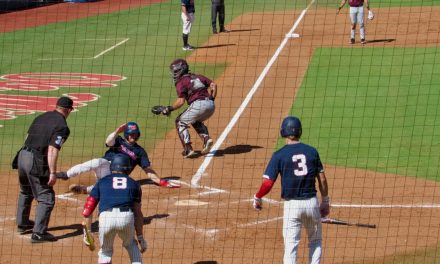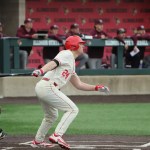
Flat-seamed baseballs may bring more beer showers

Ole Miss DH Colby Bortles at bat against ULL in the 2014 Super Regionals. (Photo Credit: Evelyn Vanpelt)
In the 2014 Men’s College World Series (MCWS), only three home runs were hit in TD Ameritrade Park Omaha. Same goes for the 2013 MCWS–three home runs. However, in 2010, the last year the series was held at Rosenblatt Stadium, 32 homers left the park.
So what happened to drastically reduce the number of home runs?
In 2011–the first year for the series to be held at the new park–bat standards were changed to make metal bats safer for players. These standards were designed to protect pitchers and fielders from increasing bat-exit speeds and to bring balance to the game that was trending heavily toward the offense. These new bats are called “Batted Ball Coefficient of Restitution” bats, “BBCOR” for short.
With the advent of the BBCOR bats, overall scoring went down dramatically. Baseball games played with these bats have been more likely to end with final scores of 3-2, rather than the 11-9 games of the 1990’s. These statistics could have a dramatic effect on how many amateur and professional teams introduce metal bats into their leagues. If they do, many teams may look at places like String King to find the best models on the market. You can look here – https://stringking.com/baseball/bbcor-baseball-bats/, for more information. This could have a significant change in the game going forward.
The love is gone?
The BBCOR bats have caused the style of the game to change, with teams playing for one-run innings instead of the big innings of years past. Long gone are the little guy homeruns, the fisted homeruns and the pop-ups that carry out.
(To learn more about the BBCOR bats and what prompted their use, click here.)
Following the move to the BBCOR bats, pitchers came inside with confidence, threw to contact, and–if the wind was just right–left the ball up, practically daring batters to hit it out.
With much lower home run tallies, the games seemed less exciting to many fans. However, for safety reasons, the NCAA cannot move away from the BBCOR bats, as any transition back to the old bats could lead to lawsuits. So, the NCAA has done the next best thing–it has lowered the seams on the baseball.
Flat-seamed baseballs may bring more beer showers
The Division I Baseball Committee made the decision to move to the flat-seamed balls starting with the 2015 Division I tournament. Influencing the committee’s decision was research conducted by the Washington State University Sport Science Laboratory that showed: “flat-seamed baseballs launched out of a pitching machine at averages of 95 mph, a 25-degree angle and a 1,400 rpm spin rate traveled around 387 feet compared to raised-seamed baseballs that went 367 feet.”
The bottom line is baseballs with flatter seams will travel farther-somewhat offsetting the effects of the BBCOR bats. Perhaps we may see more beer showers at Swayze Field in Oxford?
Diamond Rebels scrimmage with the new baseballs
I took a trip to Oxford this weekend to watch the 2014-15 Ole Miss Rebels baseball team scrimmage. I wanted to see if I could notice a difference in ball flight. The balls do seem to travel farther.
One of Sikes Orvis’ hits looked like it was going to be a routine fly ball to centerfield, but when it landed it crashed into the base of the centerfield wall.
Freshman Tate Blackman hit a ball that might still be in orbit. Routine fly balls were making the warning track or farther.
Following the scrimmage, I talked to a few players about the new balls, and their sentiments were similar to my observations. The comments they made included: “they just kept going and going;” “the carry is ridiculous;” and, “there will definitely be more tanks hit this year.”
From what I saw this weekend, I think it is safe to say pitchers’ ERAs will go up and so will the interest in the college game–and, just maybe, the number of beer showers, too!






















this is a nice step NCAA. I prefer more interesting game with lot of home runs.